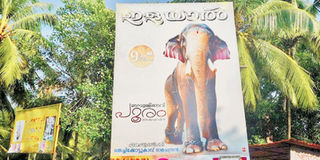GOING PLACES: Retreat to Kerala for full-body cleansing

A billboard announcing the elephant parade in Kerala, India. PHOTO| LUT LAENEN FOX
What you need to know:
Travelling to Kerala from Nairobi is easy, as most airlines from the Middle East fly to Kochi (Cochin). After landing, it takes about two hours’ drive north along a narrow two-lane coastal road to get to Rajah Island.
The area has a Kenya Coast appearance, so I felt immediately at home: temperature around 30°C, palm trees galore, yellow flowered cassias, plenty of small (smart and new) tuktuks, and hundreds of motorbikes and mopeds (many of them with female riders), zigzagging their way around cars and buses.
I am lying on a wooden table smothered with warm oil infused with herbs. Two pairs of hands are performing a choreographed body massage. This afternoon, I will be treated to a foot massage and a face pack.
I am in Kerala, in South-West India, for an ayurvedic (life knowledge) retreat. After two weeks of different massages, herbal medicines, traditional therapies, daily yoga and healthy food, all prescribed and followed up by doctors, I will be cleansed inside and outside.
The Rajah Ayurvedic Centre is located near Chettuva, on an island in one of the many lagoons of the Kerala Backwaters, surrounded by mangroves.
It attracts guests from all over the world: North America, Malaysia, Egypt, Kenya, but mostly from European countries like Sweden, France, Switzerland, Germany and U.K.
Many visitors are of Indian origin, but living abroad. Many are seeking treatment for various conditions such as joint pains, diabetes, eczema, asthma, blood disorders.. Or they come to lose or gain weight, to quit smoking, or to be rejuvenated. Many guests return each year.
Travelling to Kerala from Nairobi is easy, as most airlines from the Middle East fly to Kochi (Cochin). After landing, it takes about two hours’ drive north along a narrow two-lane coastal road to get to Rajah Island.
The area has a Kenya Coast appearance, so I felt immediately at home: temperature around 30°C, palm trees galore, yellow flowered cassias, plenty of small (smart and new) tuktuks, and hundreds of motorbikes and mopeds (many of them with female
riders), zigzagging their way around cars and buses.
Small kiosks and supermarkets, hardware dukas and fruit stalls, are interspersed with temples, churches and mosques.
Kerala has a very mixed society, where various religions live harmoniously. Unlike in East and Central Africa, the Christian connection in Kerala goes back to the early 3rd century AD.
VOCAL HOUSES OF WORSHIP
Mind you, the various houses of worship are very vocal, and at times there was a lot of drumming, chanting, fireworks and other celebrations going on. And the incessant croaking of hundreds of Indian house crows during the day made it not always the
quiet environment I expected.
But back to the roads... I immediately noticed that there was hardly any rubbish strewn around. It certainly helps that shops do not pack their wares in plastic bags! Another noticeable difference with our coast (and Kenya overall) is the level of security
measures on the houses.
Many of them are new and apparently built with expatriated money earned in the Gulf States. Although they have barred windows, the surrounding walls are low and most of the gates stay open during the day.
Are you also fed up with all the billboards in Kenyan towns and cities? They are nothing compared with the overload of advertising notices, shop signs, wall paintings, posters and huge billboards, in the area north of Kochi.
India is gearing up for an election in a couple of months. During my stay, I saw the red hammer and sickle flag of the Communists and the green crescent and star of the Islamists decorating the road. Each party, so I was told by a taxi driver, is allowed to
campaign and hold rallies during only a designated week. Not a bad measure to avoid clashes by rival supporters.
In between treatments I explored nearby places of interest. In the company of other Rajah Island guests, I visited one of the many deserted beaches of the Arabian Sea. A boat trip brought us close up to the local fishing industry, relying on sea-faring boats as
well as on the traditional dug-out canoes. And of course, we squeezed in a shopping trip for silks and other fabrics to Trisshur, the nearest commercial centre. It is like a town of a hundred Biashara Streets.
Despite it being very busy and a bit chaotic, the people are very relaxed, and we had a great time exploring the market area with its mountains of fresh vegetables and fruits. At one point, we noticed a long queue of men outside a shop: a state-controlled
alcohol outlet.
In Guruvayur, 33km north-west of Trisshur, we visited the Sri Krishna temple, a popular pilgrim destination. It houses 58 trained elephants at an old palace of the local Zamorin rulers.
It is such a contrast to see elephants in captivity when we have the opportunity to experience their African kin in the wild.
Between February and April is the Temple Festival time, with elephant parades in honour of the god Ganesh.
On my last day in Kerala, preparations were in full swing for an outing of one of the famous elephants, Thechicot Ramachamdran (check out his Facebook page). But I will have to return another time to meet him.
You can get more information on: www.ayurvedichospital.com and www.ayurvedayoga.co.ke.




